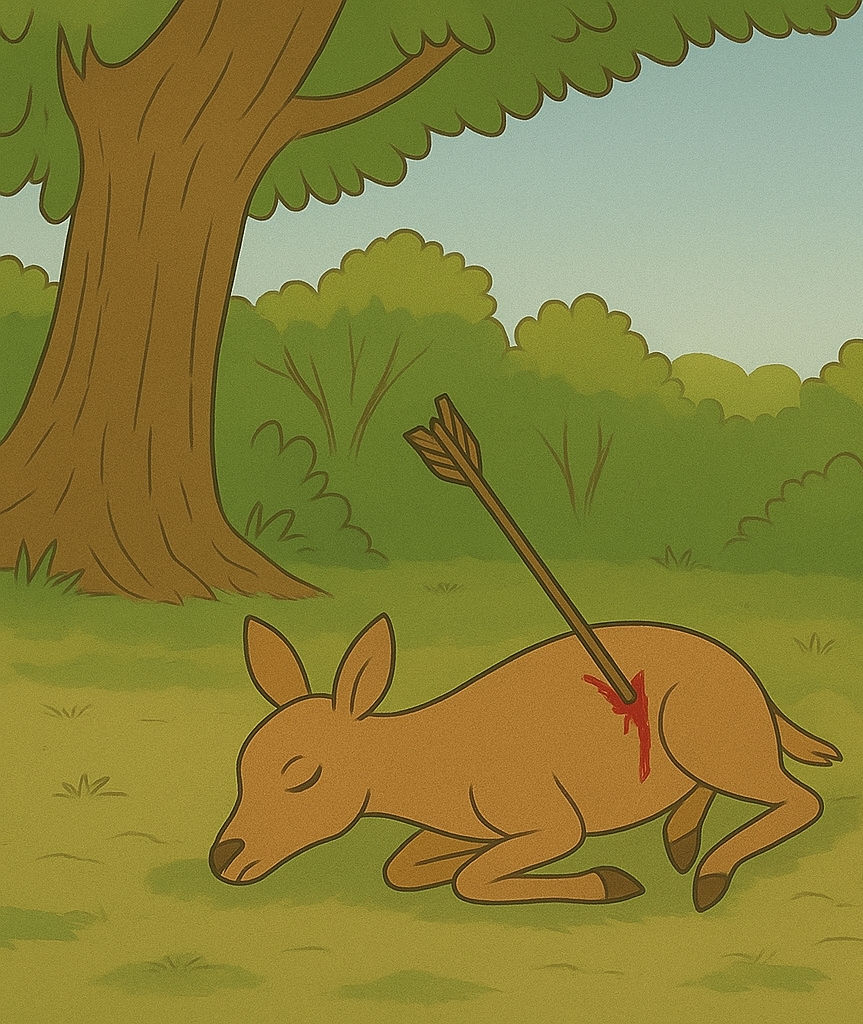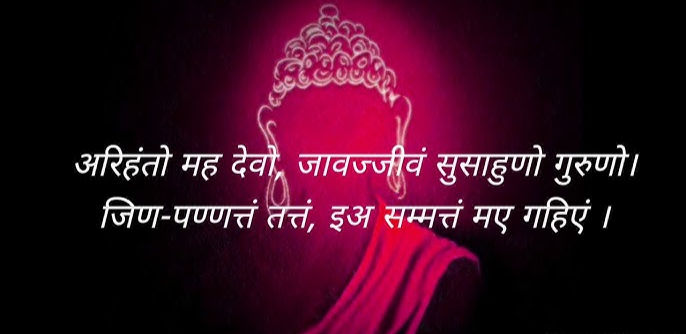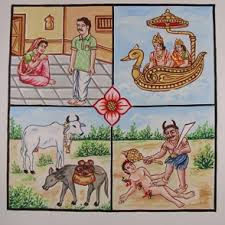Dharma Shiksha - Class 14
- Pooja Jain
- Sep 8
- 5 min read
Updated: Sep 9
Jai Jinendra everyone!
Welcome to the recap of yet another fruitful Dharma Shiksha session which taught the kids a lot about the importance of "Vandana."
We began with a quick recap of the Tikkhutto Path - the ultimate Guru Vandana Path.
The kids still need to practice its correct pronunciation, so we humbly request the parents to assist them.

Next, to make them understand the importance of vandana, we narrated a short story.
The Story of King Shrenik and His Pure-Hearted Vandana
Long ago, there was a king named Shrenik. He was strong, but not always kind.
One day, he went hunting in the forest. He shot an arrow at a deer.

When he came closer, he saw the deer was a mother deer, carrying a baby! Instead of feeling sorry, he laughed and thought, “Wow! I hit two with one arrow!”
That cruel thought made his soul collect a LOT of bad karma. It became one of the many reasons behind his going to the 7th Narak in his next lifetime.
PS: Did you know that in the shape of our Lok (Universe), there are 7 naraks right under the Madhya Lok that we're living in. The lower you go, the more terrifying and dangerous the Naraks become. This means that 1st Narak is the LEAST terrifying while the 7th one is the MOST terrifying.

Meeting Bhagwan Mahavir Swami
As time passed, King Shrenik came into contact with Bhagwan Mahavir Swami. When he listened to Bhagwan's beautiful words and sermons, King Shrenik's heart became softer and kinder over time.
One day, King Shrenik got to know that Bhagwan Mahavir was visiting his city Rajgrihi along with many of his disciples. The King's heart filled with great respect and the desire to meet Him.
When he finally saw Bhagwan, he bowed down with utmost respect and did proper vandana with Tikkhutto Path.
Then he saw Bhagwan's disciples and once again, his heart filled with great respect.
He thought, "How great are these sadhus that they're leading such a pious life under Bhagwan Mahavir Swami and follow the path of Moksha."
Now he started bowing down before the sadhus one-by-one and did proper vandana with Tikkhutto Path.

But once he had bowed down to around 200 sadhus, King Shrenik felt really tired, so he stopped.
Bhagwan Mahavir asked him, “Why did you stop, King Shrenik?”
The King said, “I’m too tired, Bhagwan.”
Bhagwan Mahavir smiled and said, “You are not getting tired, Shrenik. In fact, your soul is shedding the tiredness it was carrying for so many years!"
King Shrenik did not understand what Bhagwan was trying to say, so Bhagwan explained in detail.
He said, "Shrenik, the heaviness of your past bad karma is leaving you. Earlier, because of your bad deeds, you were destined to go to the 7th Narak - which is the worst of all Naraks. But by doing vandana with a pure heart, you have changed that! Now, you will only go to the 1st Narak - that too for a much shorter time.”
Hearing this, King Shrenik was amazed. He thought, “Wow! Just by bowing with respect, my bad karma reduced so much!”
So he quickly started bowing down before the rest of the sadhus again. But this time, he was thinking, “If I bow more, maybe I’ll erase all my bad karma!”
Bhagwan Mahavir gently told him, “Shrenik, now this vandana will not work the same way, because selfishness (swaarth) has crept into your heart. The first time, your feelings were pure. That’s why it worked so well.”
Just a Story - But With a Deep Meaning
Now kids, it is important to understand that this is just a story because if once you've done a very bad karma and are destined to go to 7th Narak in the next lifespan, no amount of good karma can change that.
So does that mean all the vandana that King Shrenik did didn't do any good to his soul?
Of course it did a lot of good to the King's soul! By doing vandana with such great respect and pure bhav helped King Shrenik shed a lot of bad karma and reduced SO many lifespans that he would have otherwise spent in the Naraks in future.
This is the power of our "Tikkhutto Path" - when we recite it with pure bhav in front of our gurus, we shed tons of bad karma and make our soul lighter!
New Learnings
After the fun-filled and informative storytelling session, the kids were taught the correct pronunciation of the first few lines of the great "Arihanto Mah Devo" Path.

Please make the kids revise this much portion of the Arihanto Path and make sure their pronunciation is correct.
Who are our Tirthankars?
Before we start making the kids learn the names of our great 24 Tirthankars, it is important for them to understand who our Tirthankars are.
The word "Tirth" can mean two things:
Dravya Tirth:
Think of Dravya Tirth like a special playground for the soul. It is a real place you can go to—like a temple, gurudwara or any other holy place. When you go there, you feel peaceful, calm and closer to God.
Bhaav Tirth:
Now "Bhaav" Tirth is different. It’s not a place you can walk to. Instead, it’s made up of people—the ones who are on their spiritual journey towards Moksha. These are:
Sadhus
Sadhvis
Shravaks (men who follow Jain teachings)
Shravikas (women who follow Jain teachings)
A Tirthankar Bhagwan is the one who starts this Bhaav Tirth. He is like a gardener who plants seeds of spirituality. Then the sadhus, sadhvis, shravaks and shravikas are like flowers that grow and spread its fragrance everywhere.
So in short, "Tirth ki sthapna karne wale Tirthankar!"
How do Tirthankar Bhagwan help us?

Now imagine there’s a huge, rough river full of strong waves. In the strong currents of the waves, there are people are stuck, trying to stay afloat. They can see the land of peace and happiness far away, but they can't reach there.
Most people don’t know how to cross the river safely. They might drown if they try alone.
Here come our Tirthankar Bhagwan. A Tirthankar is the Guru who gives these drowning people a boat - the boat of Dharma.
Then He calls out: “Come onto this boat carefully if you want to reach the land of peace!”
The people who choose to get on the Dharma boat will be safe, the rest will drown in misery.
So essentially, Tirthankars do not pick people up and carry them across. Instead, they show the path - and anyone who walks on it with care can cross safely.

Now here the rough river symbolizes "Sansaar" - the 4 gatis in which souls take birth again and again. They have to face innumerable hardships, but they can only cross this river through a strong and capable boat.

Here, the boat symbolizes Dharma. Sadhu, Sadhvi, Shravak and Shravika are the 4 pillars of Dharma. If a soul gets onto any of these boats, it is sure to cross the river of Sansaar one day.
The beautiful land of peace symbolizes Moksha. A soul can take the help of Dharma boat to reach the Moksha-Land.
So in a nutshell, our Tirthankars give us "Dharma" Boat so that we can safely cross the "Sansaar" River to reach the place of ultimate happiness - "Moksha"-Land!
Names of our first 6 Tirthankars:
Now that we know who our Tirthankars are and how they can help us reach our ultimate destination, let us now also try to learn their names. Listed below are the names of our first six Tirthankars.
Shri Rishabh Dev Ji or Shri Adinath Ji
Shri Ajitnath Ji
Shri Sambhavnath Ji
Shri Abhinandannath Ji
Shri Sumatinath Ji
Shri Padamprabh Ji
Please learn them by heart - and as Shri Prabhas Muni Maharaj Ji said - if possible, try to learn the names of next 6 too!




Comments